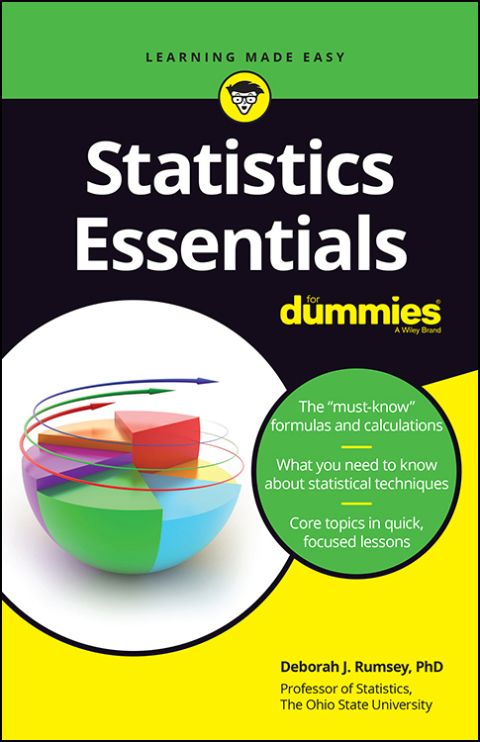Description
Efnisyfirlit
- Cover
- Introduction
- About This Book
- Conventions Used in This Book
- Foolish Assumptions
- Icons Used in This Book
- Where to Go from Here
- Chapter 1: Statistics in a Nutshell
- Designing Studies
- Collecting Data
- Describing Data
- Analyzing Data
- Making Conclusions
- Chapter 2: Descriptive Statistics
- Types of Data
- Counts and Percents
- Measures of Center
- Measures of Variability
- Percentiles
- The Five-Number Summary
- Chapter 3: Charts and Graphs
- Pie Charts
- Bar Graphs
- Time Charts
- Histograms
- Boxplots
- Chapter 4: The Binomial Distribution
- Characteristics of a Binomial
- Finding Binomial Probabilities Using the Formula
- Finding Probabilities Using the Binomial Table
- The Expected Value and Variance of the Binomial
- Chapter 5: The Normal Distribution
- Basics of the Normal Distribution
- The Standard Normal (Z) Distribution
- Finding Probabilities for X
- Finding X for a Given Probability
- Normal Approximation to the Binomial
- Chapter 6: Sampling Distributions and the Central Limit Theorem
- Sampling Distributions
- Finding Probabilities for
- The Sampling Distribution of the Sample Proportion
- Finding Probabilities for
- Chapter 7: Confidence Intervals
- Making Your Best Guesstimate
- The Goal: Small Margin of Error
- Choosing a Confidence Level
- Factoring in the Sample Size
- Counting on Population Variability
- Confidence Interval for a Population Mean
- Confidence Interval for a Population Proportion
- Confidence Interval for the Difference of Two Means
- Confidence Interval for the Difference of Two Proportions
- Interpreting Confidence Intervals
- Spotting Misleading Confidence Intervals
- Chapter 8: Hypothesis Tests
- Doing a Hypothesis Test
- Testing One Population Mean
- Testing One Population Proportion
- Comparing Two Population Means
- Testing the Mean Difference: Paired Data
- Testing Two Population Proportions
- You Could Be Wrong: Errors in Hypothesis Testing
- Chapter 9: The t-Distribution
- Basics of the t-Distribution
- Understanding the t-Table
- t-Distributions and Hypothesis Tests
- t-Distributions and Confidence Intervals
- Chapter 10: Correlation and Regression
- Picturing the Relationship with a Scatterplot
- Measuring Relationships Using the Correlation
- Finding the Regression Line
- Making Predictions
- Avoid Extrapolation!
- Correlation Doesn’t Necessarily Mean Cause-and-Effect
- Chapter 11: Two-Way Tables
- Organizing and Interpreting a Two-Way Table
- Finding Probabilities within a Two-Way Table
- Checking for Independence
- Chapter 12: A Checklist for Samples and Surveys
- The Target Population Is Well Defined
- The Sample Matches the Target Population
- The Sample Is Randomly Selected
- The Sample Size Is Large Enough
- Nonresponse Is Minimized
- The Survey Is of the Right Type
- Questions Are Well Worded
- The Timing Is Appropriate
- Personnel Are Well Trained
- Proper Conclusions Are Made
- Chapter 13: A Checklist for Judging Experiments
- Experiments versus Observational Studies
- Criteria for a Good Experiment
- Inspect the Sample Size
- Examine the Subjects
- Check for Random Assignments
- Gauge the Placebo Effect
- Identify Confounding Variables
- Assess Data Quality
- Check out the Analysis
- Scrutinize the Conclusions
- Chapter 14: Ten Common Statistical Mistakes
- Misleading Graphs
- Biased Data
- No Margin of Error
- Nonrandom Samples
- Missing Sample Sizes
- Misinterpreted Correlations
- Confounding Variables
- Botched Numbers
- Selectively Reporting Results
- The Almighty Anecdote
- Appendix: Tables for Reference
- Index
- About the Author
- Advertisement Page
- Connect with Dummies
- End User License Agreement






Reviews
There are no reviews yet.